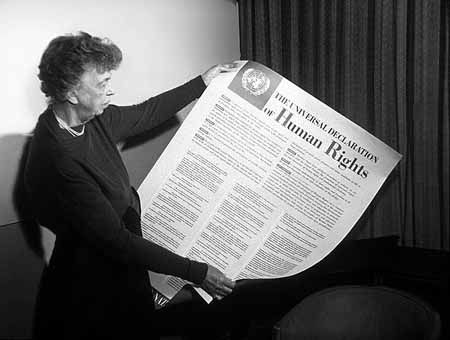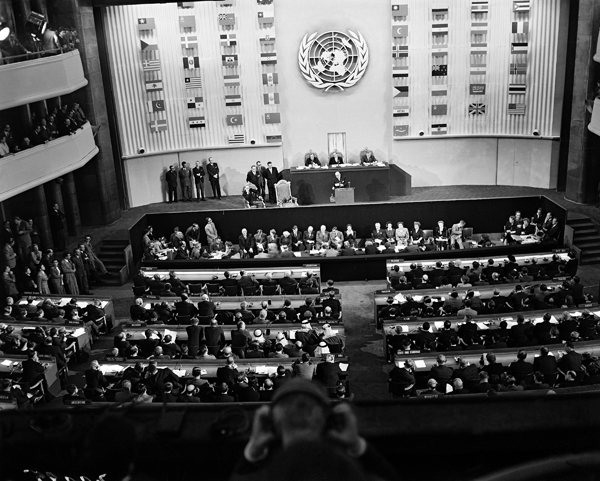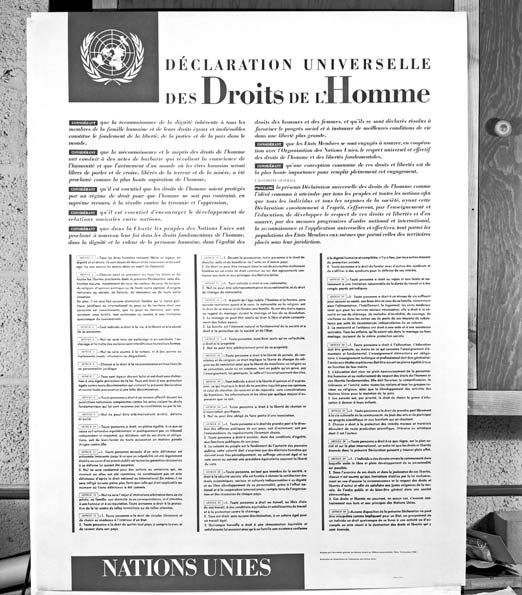Universal Declaration of Human Rights, 1948
About the Declaration
In 1948, the United Nations General Assembly adopted the Universal Declaration of Human Rights, which represents “a common standard of achievement for all peoples and all nations.”
What are Human Rights?
Human Rights are “the recognition of the inalienable dignity of human beings” (1). Free of discrimination, inequality, or distinction of any kind, human dignity is universal, equal and inalienable.
“All human beings are born free and equal in dignity and rights.”
Beyond the concept, Human Rights are expressed and defined in legal texts, which seek to guarantee the dignity of human beings and to make it a reality.
Origin of the Universal Declaration of Human Rights
 The philosophy of Human Rights began with the Enlightenment. In The Social Contract (I,4), Rousseau sought “a form of association … in which each, while uniting himself with all, may still obey himself alone, and remain as free as before.”
The philosophy of Human Rights began with the Enlightenment. In The Social Contract (I,4), Rousseau sought “a form of association … in which each, while uniting himself with all, may still obey himself alone, and remain as free as before.”
The 1948 text of the Universal Declaration of Human Rights is inspired by the 1789 text of The Declaration of the Rights of Man and of the Citizen.
After the horrors of the Second World War, the international community decided to draw up an international charter of rights that would affirm the values put forward in the struggle against fascism et Nazism.
The drafting of such a charter was entrusted to a committee chaired by Eleanor Roosevelt and composed of members from 18 countries. The Charter was drafted by Canadian John Peters Humphrey, and then revised by Frenchman René Cassin.
The final text is pragmatic and the result of numerous political consensuses, so that it would gain widespread approval.
 The Universal Declaration of Human Rights was adopted by the third General Assembly of the United Nations on 10 December 1948 in Paris.
The Universal Declaration of Human Rights was adopted by the third General Assembly of the United Nations on 10 December 1948 in Paris.
None of the 56 members of the United Nations voted against the text, but South Africa, Saudi Arabia and the Soviet Union abstained.
““In the midst of the Cold War and in the face of growing opposition to colonialism, it took two decades for the United Nations to agree on how to make it legally binding.” [our translation] (1)
Content of the Universal Declaration of Human Rights
 The Universal Declaration of Human Rights is the “common standard of achievement for all peoples and all nations.”
The Universal Declaration of Human Rights is the “common standard of achievement for all peoples and all nations.”
The Universal Declaration of Human Rights states that “motherhood and childhood are entitled to special care and assistance” and describes the family as “the natural and fundamental group unit of society.”
Although children are seldom mentioned in this text, it is nevertheless a significant document, and its impact on all human beings, including children, is what makes the Declaration so important. In fact, children’s rights are based on human rights.
The 1959 Declaration of the Rights of the Child highlighted the unique nature of childhood and thus the application of rights pertaining specifically to children.

